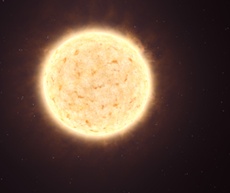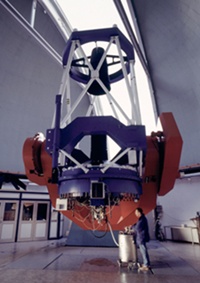Max Planck scientists detect an exoplanet which circles an immigrant red giant
26 Nov 2010
Astronomers have discovered the first exoplanet that originated in another galaxy. The planet's host star belongs to a dwarf galaxy which was swallowed up by our home galaxy, the Milky Way, billions of years ago.
 |
| An exoplanet from another galaxy (right) and its star (left): Artist's impression of the yellowish star HIP 13044 and, on the bottom right, its planet HIP 13044 b. HIP 13044 is part of a stellar stream, a remnant of a dwarf galaxy that was swallowed by the Milky Way galaxy billions of years ago. Image: ESO / L. Calçada |
Remarkably, the Jupiter-like planet orbits a star nearing the end of its life. It appears to have survived the star's "Red giant" stage, which offers a tantalizing glimpse of one possible fate of our own Solar System in the distance future. The results are published on November 18 in Science Express.
 |
| The 2.2 metre ESO/MPG telescope at ESO's La Silla observatory in Chile has been in operation since early 1984 and is on indefinite loan to ESO from the Max Planck Society. The observations of the new exoplanet were made with the high-resolution spectrograph FEROS, which was built by a European consortium led by the Landessternwarte Königstuhl in Heidelberg. Image: ESO / H.H.Heyer |
Over the last 15 years, astronomers have detected nearly 500 exoplanets orbiting ordinary stars in our cosmic neighbourhood. Now, for the first time, astronomers have detected an exoplanet whose origin appears to lie outside our own galaxy.
The planet, which has been designated HIP 13044 b, has a minimum mass of 1.25 times the mass of Jupiter. The star system is located about 2000 light-years from Earth in the southern constellation Fornax ("the chemical furnace").
The planet was discovered with the radial velocity method which measures tiny wobbles of a star caused by a planet's gravitational pull. HIP 13044's wobbles were detected with the high-resolution spectrograph FEROS at the 2.2 m MPG-ESO telescope at ESO's La Silla observatory in Chile.
The planet and its host star appear to have originated in a dwarf galaxy that was swallowed by the Milky Way galaxy between six and nine billion years ago.
Such galactic cannibalism is an ordinary occurrence in galactic evolution. Typically, remnants of swallowed-up dwarf galaxies can be detected as ribbon-like arrangements of stars known as "stellar streams". In this case, HIP 13044 is part of the so-called "Helmi stream".
"This is an exciting discovery," says Rainer Klement of the Max Planck Institute for Astronomy (MPIA), who was responsible for the selection of the target stars for this study. "For the first time, astronomers have detected a planetary system in a stellar stream of extragalactic origin. Because of the great distances involved, there are no confirmed detections of planets in other galaxies. This cosmic merger has brought an extragalactic planet within our reach".
The newly discovered system has a number of unusual properties. "We found HIP 13044 b as part of a systematic search for exoplanets around stars that are nearing the end of their life," says MPIA's Johny Setiawan, who led the research.
While the host star HIP 13044 was probably rather similar to our own Sun earlier on, it has since gone through the "Red Giant" phase, in which a star cools and expands to hundreds of times the radius of the Sun. It has now settled down into another quiet phase powered by the nuclear fusion of helium, which is expected to last a few million years in total.
The fact that the exoplanet survived the red giant stage provides an intriguing glimpse of one possible fate of our own planetary system: our Sun is expected to become a Red Giant in around five billion years.
Setiawan and his colleagues hypothesize that the current close orbit of HIP 13044 b - its present average distance to its host star amounts to a mere 12 per cent of the distance between the Sun and the Earth, with an orbital period of only 16.2 days - was initially much larger, and that the planet migrated inwards during the star's Red Giant phase.
There is some evidence that some closer-in planets did likewise, and did not survive: "HIP 13044 is rotating relatively quickly for a star of this particular type," says Setiawan. "One explanation is that HIP 13044 swallowed its inner planets during the Red Giant phase, which would make the star spin more quickly." The survival of HIP 13044 b might be in jeopardy, however. In the next stage of its evolution the star will again expand and may engulf the planet.
With only this single data point, it is impossible to tell how common this particular evolution is. More definite conclusions - and an understanding of how much HIP 13044 tells us about our own planetary system's future - will only be possible once significantly more planets orbiting late-type stars have been found, which is the aim of Setiawan and his colleagues in the ongoing search.
One final puzzle: The new planet's host star HIP 13044 appears to contain very few elements heavier than hydrogen and helium (in technical terms, it is "extremely metal-poor") - less than any other star with planets. "It is a puzzle for the widely accepted model of planet formation of how such a star, which contains hardly any heavy elements at all, could have formed a planet," adds Setiawan.






























